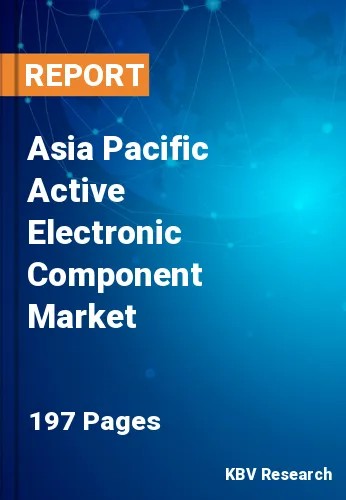The Asia Pacific Active Electronic Component Market would witness market growth of 6.7% CAGR during the forecast period (2023-2030). In the year 2021, the Asia Pacific market's volume surged to 2,265.6 million units, showcasing a growth of 5.3% (2019-2022).
Active electronic components are used in the aerospace and defense sectors in avionics, radar systems, communication equipment, and guidance systems. These components must meet stringent reliability and performance standards. RF components, microprocessors, memory devices, and power management ICs are vital in this industry. In the energy sector, active electronic components play a role in smart grid technologies, renewable energy systems (such as solar inverters), and power distribution and control systems. Power semiconductors, microcontrollers, and sensors are used to optimize energy efficiency and monitor electrical grids.
In addition, advancements in semiconductor technology have led to the development of new types of active electronic components, including sensors, MEMS (Micro-Electro-Mechanical Systems), and RF (Radio Frequency) devices. These components enable innovations like IoT (Internet of Things) and wireless communications. Key drivers for the market include the growing demand for electronic devices, increasing connectivity and digitization, the proliferation of smartphones and wearable technology, and the need for energy-efficient components.
The market is continually evolving due to advancements in semiconductor technology and the need for more efficient, compact, and specialized components. Wide bandgap materials like silicon carbide (SiC) and gallium nitride (GaN) are gaining prominence. These materials offer higher breakdown voltages and faster switching speeds than traditional silicon, making them ideal for power electronic devices, high-frequency RF applications, and advanced power amplifiers. Quantum dots are nanoscale semiconductor particles with unique optical and electronic properties. They are used in displays, particularly in quantum dot displays (QLEDs), where they enhance colour accuracy and brightness.
The Chinese government is expanding and deepening a statist approach to developing technologies and sectors prioritized in its Made in China 2025 and other industrial plans. In 2019, China revised the goal upward, setting an objective of expanding its domestic production of semiconductors (including from foreign firms in China) to meet 80% of domestic demand by 2030, as part of its Made in China 2025 industrial strategy. These factors will help boost demand in the market in the upcoming years.
The China market dominated the Asia Pacific Active Electronic Component Market by Country in 2022 and would continue to be a dominant market till 2030; thereby, achieving a market value of $64,648.4 million by 2030. The Japan market is registering a CAGR of 5.9% during (2023 - 2030). Additionally, The India market would showcase a CAGR of 7.3% during (2023 - 2030).
Based on Product Type, the market is segmented into Semiconductor Devices (Integrated Circuits (ICs), Transistors, Diode, Optoelectronics), Vacuum Tube, Display Devices and Others. Based on End User, the market is segmented into Consumer Electronics, Networking & Telecommunication, Manufacturing, Aerospace & Defense, Automotive, Healthcare and Others. Based on countries, the market is segmented into China, Japan, India, South Korea, Singapore, Malaysia, and Rest of Asia Pacific.
Free Valuable Insights: The Global Active Electronic Component Market is Predict to reach $477.7 Billion by 2030, at a CAGR of 6.4%
The market research report covers the analysis of key stake holders of the market. Key companies profiled in the report include Technologies AG, Advanced Micro Devices, Inc., STMicroelectronics N.V., Microchip Technology, Inc., Analog Devices, Inc., Broadcom Inc., NXP Semiconductors N.V., Intel Corporation, Texas Instruments, Inc., Toshiba Corporation, Skillsoft Corporation.
By Product Type (Volume, Million Units, USD Million, 2019 to 2030)
By End User (Volume, Million Units, USD Million, 2019 to 2030)
By Country (Volume, Million Units, USD Million, 2019 to 2030)
Our team of dedicated experts can provide you with attractive expansion opportunities for your business.

